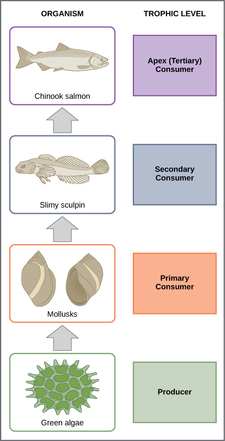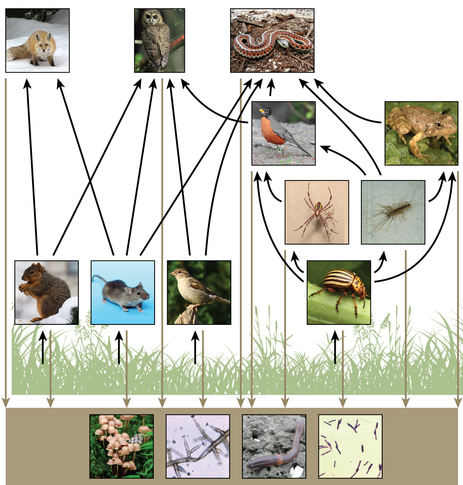READING OVERVIEW OF ECOLOGY
Importance of Soil
|
|
|
Soil is not simply dirt. Soil contains an entire ecosystem of microorganisms. The video below shows some of the organisms that can be found in most soils. At the beginning of the video the scientist uses a micropipette to collect a small amount of water that contains the microorganisms.
|
Nematodes are the most numerous multicellular animals on earth. A handful of soil will contain thousands of the microscopic worms, many of them parasites of insects, plants or animals.
Protozoa are single-celled animals that feed primarily on bacteria, but also eat other protozoa, soluble organic matter, and sometimes fungi. They are several times larger than bacteria. Fungi are microscopic cells that usually grow as long threads or strands called hyphae, which push their way between soil particles, roots, and rocks. Hyphae are usually only several thousandths of an inch (a few micrometers) in diameter. A single hyphae can span in length from a few cells to many yards. A few fungi, such as yeast, are single cells. Because of its decomposition properties, soil mites love compost. You may find several different species of bin mites in compost, including predatory fast moving mites that are flat and light brown. |
|
Importance of Water
|
Like soil, water in the environment is not simply H2O. Water contains many microorganisms (including bacteria, cyanobacteria, protozoa, algae, and tiny animals such as rotifers) that play a role in maintaining the ecosystem. These organisms provide food for other organisms in the food web and they recycle important molecules such as nitrogen and oxygen. While most of the biomolecules needed by animals come from plants, some bacteria can also use the energy from the sun to make biomolecules. Animals that eat the bacteria or the plants can get the energy they need from the bonds in the biomolecules.
|
|
Using Microscopes
Food Webs
|
A food chain is a linear sequence of organisms through which nutrients and energy pass as one organism eats another; the levels in the food chain are producers, primary consumers, higher-level consumers, and finally decomposers. These levels are used to describe ecosystem structure and dynamics. There is a single path through a food chain. Each organism in a food chain occupies a specific trophic level (energy level), its position in the food chain or food web.
In many ecosystems, the base, or foundation, of the food chain consists of photosynthetic organisms (plants or phytoplankton), which are called producers. The organisms that consume the producers are herbivores: the primary consumers. Secondary consumers are usually carnivores that eat the primary consumers. Tertiary consumers are carnivores that eat other carnivores. Higher-level consumers feed on the next lower trophic levels, and so on, up to the organisms at the top of the food chain: the apex consumers. In the Lake Ontario food chain, shown to the right, the Chinook salmon is the apex consumer at the top of this food chain. One major factor that limits the number of steps in a food chain is energy. Energy is lost at each trophic level and between trophic levels as heat and in the transfer to decomposers. Thus, after a limited number of trophic energy transfers, the amount of energy remaining in the food chain may not be great enough to support viable populations at yet a higher trophic level. |
There is a one problem when using food chains to describe most ecosystems. Even when all organisms are grouped into appropriate trophic levels, some of these organisms can feed on more than one trophic level; likewise, some of these organisms can also be fed on from multiple trophic levels. In addition, species feed on and are eaten by more than one species. In other words, the linear model of ecosystems, the food chain, is a hypothetical, overly simplistic representation of ecosystem structure.
A holistic model—which includes all the interactions between different species and their complex interconnected relationships with each other and with the environment—is a more accurate and descriptive model for ecosystems. A food web is a concept that accounts for the multiple trophic (feeding) interactions between each species and the many species it may feed on, or that feed on it. In a food web, the several trophic connections between each species and the other species that interact with it may cross multiple trophic levels. The matter and energy movements of virtually all ecosystems are more accurately described by food webs.
A holistic model—which includes all the interactions between different species and their complex interconnected relationships with each other and with the environment—is a more accurate and descriptive model for ecosystems. A food web is a concept that accounts for the multiple trophic (feeding) interactions between each species and the many species it may feed on, or that feed on it. In a food web, the several trophic connections between each species and the other species that interact with it may cross multiple trophic levels. The matter and energy movements of virtually all ecosystems are more accurately described by food webs.
|
This text is adapted under a Creative Commons 4.0 license. You can find the original source here.
|
Proudly powered by Weebly

